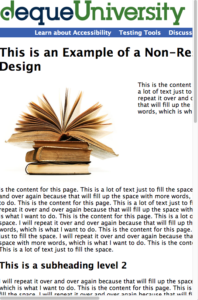Responsive Web Design – What is it and Why is it Important?
Over the last decade or so, the number of devices with web browsing potential has grown exponentially. Phones, tablets, PCs, laptops, televisions and a host of other gadgets can now find their way onto your website, all of which provide a unique perspective into how it looks.
Responsive Web Design allows a website to adapt to the size of the screen viewing it, resizing content so it fits neatly, whether being presented on a phone, computer, tablet or any other device.
It is no secret that in our current day and age, a business’ website is pivotal to its success. Long gone are the days where you would be most likely to find the best person for the job through checking your local paper or by receiving a flyer in the mail. A quick Google search and a scan of a website is how the vast majority of your prospective customers will find out about you. This is why ensuring that your website works as intended, no matter the device, is so important.
There’s no way to know which platform your customers will find your website on, so it’s best to make sure it will work smoothly on all of them.
Introducing Responsive Web Design
Responsive Web Design (RWD) allows your site to automatically adjust to a user’s screen size, platform and viewpoints. One site fits all.
RWD works by using a combination of HTML (language used to describe the structure of web pages, such as headings, links, videos etc.) and CSS (language used to describe presentation, like colour and fonts). The result is a website that is able to adapt, maximising usability and viewer satisfaction.
Deque University has made an example of an unresponsive website, which you can see below.




From the two screenshots, you can see the left image shows the website at full screen, looking good with all information clearly visible. The right image shows how the site looks when the window is made smaller, simulating what it will look like when found on a smartphone.
As this website is unresponsive, any change to the window’s size or shape can make it incredibly difficult for the user to view the website and its content. This is a surefire way to put a prospective customer off continuing to look through the site, or returning to it at a later date.
If people visit your website and leave immediately, this will increase what is called ‘bounce rate’. Google will detect a high bounce rate and drop the site in its search engine rankings as a result, leading to your website getting less exposure. RWD improves audience retention, having a great knock on effect with how highly Google will rate your site.
There are a number of RWD techniques that can be implemented when designing your website, so let’s delve a bit deeper into them and find out more.
Responsive Text


As seen in the example above, it can be hard for viewers to read the website’s content if the text is not made responsive to different devices.
After making your text responsive, the font will get bigger or smaller in tandem with the window expanding or shrinking. This will allow the text to remain easily readable for your customers, with headings and the main body text keeping their relative sizes on all devices.
For readability it is also important for the text to be able to adjust horizontally or vertically to the screens of all devices. Moving from a wide computer screen to a narrower smartphone screen should work seamlessly for a modern website. Responsive text will mean your website’s content will remain neat and easily readable, and will avoid your website looking untidy by exposing a large amount of blank space or chopping the text off the screen.
Responsive text is particularly important for any sites that rely on text-heavy content such as news, articles and blogs. If the aim of your website is to get people to read your content, ensuring the text is easily accessible and readable is a key factor in retaining online readership and attracting repeat viewers.
Responsive Images


Including images on your website is a great way to engage with your audience, grabbing their attention and giving visual examples of what the written content is talking about. However, without the use of responsive images, these pictures can actually become a hindrance and can negatively affect user experience when perusing your site.
Having clean, crisp photos on your website can make it look more attractive and professional. By making sure that your website features responsive images, the site will be able to render the same image at the highest quality possible on all devices, avoiding any stretching or squashing.
Image positioning can also be drastically affected by not being responsively designed, which can be a major issue if you are selling items from your site and are using images to accompany any product information. An image can be lined up perfectly whilst being viewed on full screen, but when viewed on a smaller window, suddenly all your images have been pushed to the bottom whilst the text remains at the top, causing confusion for your customers. By making your images responsive, everything will be kept in its intended position.
Optimising image responsiveness will also allow your website to run smoother. Images take up a large portion of the online weight of your website, so making them responsive will mean your site can deal with a large amount of traffic while preserving fast loading times.
Why Responsive Web Design is Important


We have discussed at length the different ways in which you can make your website responsive and the positive effect it will have for the site’s visitors. Now we can talk a little bit about the knock-on effects that Responsive Web Design will have on your business as a whole.
In 2015, Google announced that mobile-friendliness will be taken into consideration when suggesting your website to potential viewers. This algorithm assesses how compatible a website is when being viewed across multiple platforms and devices, and will rank that site accordingly in its search engine.
Long story short, the better your RWD is, the more likely your website is to be promoted by Google as a top search result. Needless to say, a higher Google ranking will mean your website will gain more traffic from a wider audience, leading to more sales or views, depending on what your website is set up to achieve.
By making your website easy to navigate across multiple platforms, audience retention will be increased and your website is likely to see a higher conversion rate as a result. Designing your website with RWD can also save you a bundle as you will not have to pay extra by visiting a mobile developer – it is clear that setting up your site with RWD can save time and money.
What Can We offer?


As we have talked about, equipping your site with Responsive Website Design is a great way to fast track your online success and improve your business’ results. We are now living in a multi-screened world, so having a website that can cater to everything is a huge advantage to have.
Ensuring that the design of your website is compatible across all platforms is beneficial to everyone. We at Active Internet Marketing (UK) have a team of highly skilled web designers who will work with you to create a website befitting of your business.
Contact Active Internet Marketing (UK)
Please feel free to get in touch with us and receive a free, no-obligation website audit from a member of our business development team. If you have any questions, you can call us on 01604 765 796 or fill out our online contact form.
